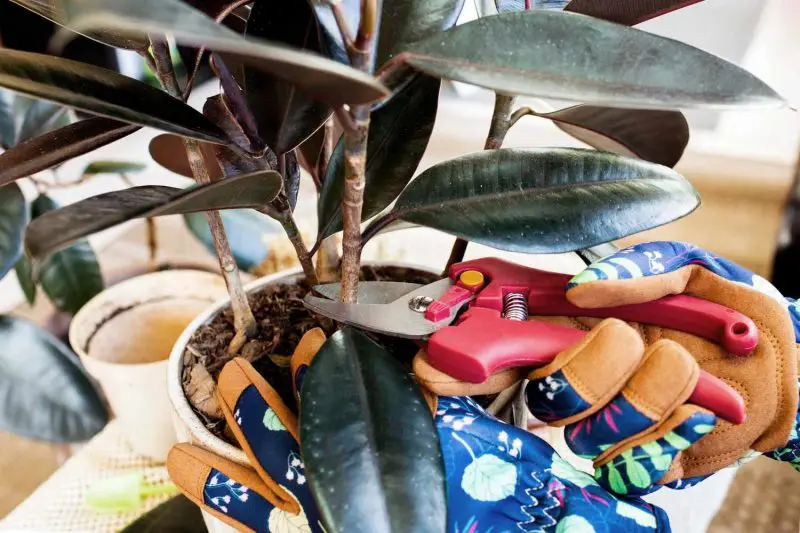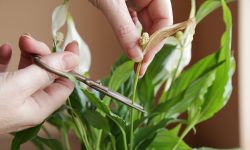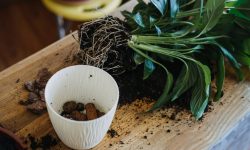Rubber plants grow into tall and striking houseplants that fill any room with bold foliage and rich green color. Many people love their strong presence but hesitate to propagate them because the process seems difficult. In reality, propagation becomes simple when you understand the plant’s natural rhythm and provide a stable environment. Rubber plants respond well to gentle care and adapt to different indoor spaces. Propagating them allows you to create new plants from a single branch. This method helps you expand your collection without needing to buy new plants. With the right steps, the process becomes a rewarding experience for beginners.
Learning how the rubber plant develops roots helps you understand what the plant needs during propagation. The plant grows in warm and humid regions, where steady moisture and filtered light support slow but strong development. When you recreate these conditions indoors, the cutting roots more easily. The process requires patience because the plant grows at its own pace. However, simple adjustments in light, soil, and humidity create the ideal atmosphere. This guide explains each step clearly so you can propagate your rubber plant with confidence. Once you master the basics, you will enjoy watching your new plant grow and settle into your home.
Understanding How Rubber Plants Naturally Grow

Rubber plants follow a slow and steady growth pattern shaped by their tropical origins. They grow in warm regions where sunlight filters through taller trees. This environment creates bright but gentle light that supports leaf development without causing stress. When you understand this natural rhythm, you can recreate similar conditions indoors. The plant grows upward with a strong central stem and produces new leaves from its tip. This structure guides how the plant responds to pruning and propagation. A cutting taken from a healthy stem grows best when conditions feel similar to its native habitat.
Growth depends on stable moisture and mild warmth. Rubber plants develop new leaves when they receive enough energy from light. Sudden changes in watering or temperature slow their rhythm and weaken the cutting. The plant reacts slowly to new environments, so consistent care helps it stay active. When the plant grows indoors, it adapts to steady care rather than dramatic shifts. This steady pace supports root formation during propagation. Understanding this pattern prepares you to guide the cutting through each stage of development.
Rubber plants also rely on strong root systems to support future growth. Once a cutting forms roots, it begins to behave like a mature plant. It develops leaves, thickens its stem, and grows at a stable pace. The plant needs time to establish its foundation before showing signs of strong growth. With patience and gentle support, the cutting becomes sturdy and independent. Understanding how the rubber plant grows allows you to create an environment where propagation succeeds. This knowledge helps you guide the cutting with confidence and encourages long-term strength in your new plant.
Choosing the Best Cutting for Successful Propagation
Selecting the right cutting determines how well a rubber plant will root. A healthy cutting gives the new plant enough stored energy to begin forming roots. The best cutting comes from a firm stem with strong leaves. This stem should show no signs of stress or damage. A cutting with at least one node has the greatest chance to root because roots grow from this point. When you choose a cutting from a healthy section, the new plant begins with a stronger foundation. This early strength helps it adapt to indoor conditions with ease.
The position of the cutting also matters. A middle or upper stem section works better than a very young tip or an older woody piece. Younger wood dries out too fast, while older wood roots slowly. A mature but flexible stem offers the right balance for rooting. The cutting should be taken with a clean tool to prevent damage. A clean cut helps the plant seal the wound and prepare for new root growth. Once you remove the cutting, it needs time to rest before planting. This rest allows the sap to dry and reduces the risk of rot.
The length of the cutting influences rooting success. A piece around fifteen to twenty centimeters supports steady growth. The cutting uses stored moisture to protect itself during early rooting. When the size remains balanced, the cutting stays strong without losing too much water. A clean node helps root development once placed in soil or water. Selecting the right cutting increases the chance of success and reduces early stress. This careful choice prepares the plant for a smooth transition into its new growth stage. When the cutting begins with strength, the propagation process becomes easier and more predictable.
Preparing Your Tools and Materials the Right Way
Preparing the correct tools ensures a clean and successful propagation process. Rubber plants release sticky sap when cut, so sharp tools help you create smooth cuts without crushing the stem. Clean scissors or pruning shears protect the plant from infection. When tools stay sharp and sterile, the cutting heals faster and roots more easily. Dirt or dull blades create rough wounds that slow recovery. Preparing your materials before cutting helps you work calmly. This preparation reduces stress on the plant and improves your overall success.
The right soil mix supports early root development. A light and airy mixture helps water move smoothly through the pot. Heavy soil traps moisture and slows root growth. A blend with peat and perlite creates the structure the cutting needs. This combination keeps the mix soft and prevents compaction. The cutting grows better when the soil stays moist but never soggy. Preparing a small pot with drainage holes allows extra water to escape. This setup protects the young roots from stress and helps maintain a healthy environment.
Having clean containers and fresh water ready also improves the rooting process. Water propagation requires clear, room-temperature water to support early root formation. Changing the water often prevents stagnation and keeps the cutting strong. Preparing labels or markers helps you track each cutting. Good organization makes the process simple and prevents mistakes. When all materials are ready, the cutting experiences fewer delays. This smooth transition from pruning to planting creates the ideal start for new growth. Preparing tools and materials carefully sets the foundation for successful propagation and strong long-term development.
Taking and Preparing the Cutting for Rooting
Taking the cutting requires careful handling to protect the plant and improve rooting success. A clean cut reduces damage and helps the stem seal quickly. When you choose a healthy stem, the cutting already holds enough stored energy to begin forming roots. Cutting just below a node gives the new plant a clear point for root growth. The sap may flow for a short time, but letting it dry helps prevent rot later. This drying stage allows the cutting to form a thin protective layer. Once the surface dries, the cutting becomes ready for soil or water.
Preparing the cutting strengthens its chances of rooting. Removing the lower leaves reduces moisture loss and allows the cutting to focus on root development. Keeping a few upper leaves helps the plant continue photosynthesis. The balance between leaf removal and leaf retention supports the cutting during its early stages. Dipping the cut end in rooting hormone offers another advantage. This step encourages faster and stronger root production. The cutting responds well to gentle support and consistent handling. A stable environment during preparation helps reduce stress and shapes early growth.
The final step before rooting involves checking the cutting for damage. Any torn edges or bruising slow down root formation. A smooth and healthy surface gives the cutting a better start. Once the cutting is ready, placing it into soil or water completes the preparation stage. Early care influences how easily the cutting adapts to its new environment. Consistent light, gentle warmth, and steady humidity support the first stages of root growth. This careful attention helps the cutting transition from a stem to a developing plant. Taking and preparing the cutting properly sets the foundation for successful propagation.
Rooting Your Rubber Plant Cutting in Water
Rooting in water offers a simple and visual way to track progress. The cutting sits in clear water where roots can form without soil pressure. This method helps beginners because they can see each stage of development. When you place the cutting in fresh water, only the node should stay submerged. Leaves must remain above the waterline to prevent rot. Clear water supports early growth by supplying steady moisture. Changing the water often keeps it clean and prevents bacterial buildup. As the cutting adjusts, the water encourages root tips to appear slowly.
Rubber plant cuttings root best in warm and bright environments. Soft brightness helps the cutting maintain its energy without stressing the leaves. Placing the container near a bright window creates the right atmosphere. Cold rooms slow the rooting process and weaken the cutting. Warmth helps roots form more quickly and supports early structure. Water should remain at room temperature to avoid shocking the stem. When conditions stay steady, the cutting focuses on producing roots at the submerged node. The rooting stage may take several weeks, but the process moves smoothly with patience.
As roots begin to appear, the cutting grows more stable. Early roots stay thin and fragile, so gentle handling is important. When the roots reach several centimeters, the cutting becomes ready for soil. Moving the cutting too early slows its progress because young roots break easily. Waiting for strong, healthy roots supports long-term success. Once the cutting moves to soil, it transitions into normal plant development. Rooting in water gives the cutting a comfortable start. With steady warmth, clear water, and gentle light, the new plant becomes strong enough to grow independently in its new pot.
Rooting Your Rubber Plant Cutting in Soil
Rooting the cutting in soil creates a more natural start for the new plant. Soil provides structure and gentle resistance that help the cutting grow strong roots. When you place the cutting into a light and airy mix, the stem settles comfortably. The node remains slightly below the surface, where roots can form without pressure. Moist soil supports early hydration while allowing air to reach the root zone. This balance helps the cutting adjust to its new environment. Soil rooting takes patience, but it prepares the plant for long-term growth.
Warmth plays a major role during this stage. A warm room encourages steady root development and prevents stress. Soft brightness helps the cutting maintain energy without overheating. Direct sunlight harms the young stem and dries the soil too quickly. Even moisture supports early root formation. Overwatering slows the process by drowning the node and limiting airflow. Allowing the top layer of soil to dry slightly between waterings keeps conditions balanced. The cutting responds well to consistency and begins forming roots at a stable pace.
As roots develop, the cutting becomes more secure in its new pot. Early signs of success include firmer leaves and slow but steady growth. Avoid disturbing the cutting while roots form because movement breaks the fragile root tips. Gentle conditions allow the plant to focus on building a foundation. Once the cutting becomes stable, it starts behaving like a mature rubber plant. New leaves appear from the top, and the stem thickens with time. Rooting in soil helps the plant adapt quickly to indoor conditions. With patience, warmth, and soft light, the cutting grows into a strong and independent plant.
Caring for the Cutting During the Rooting Stage
Caring for the cutting during rooting determines how strong the new plant will become. The cutting needs steady moisture to support its early development, but it cannot sit in soggy conditions. Moisture should feel gentle and balanced. Warmth encourages the cutting to stay active, so placing it in a warm room helps maintain early growth. Soft brightness gives the cutting enough energy without creating stress. Direct sunlight harms the young stem and dries it too quickly. When conditions stay calm and consistent, the cutting begins forming roots at a steady pace.
Humidity also supports the cutting during this stage. Young rubber plant cuttings lose moisture faster than mature plants. A slightly humid environment prevents the leaves from drying and keeps the stem hydrated. Covering the pot loosely with a clear plastic dome creates a warm and moist atmosphere. This mini environment helps reduce stress and supports root growth. The cutting still needs airflow, so the cover should not be sealed. A gentle balance between moisture and airflow allows the cutting to breathe and adjust to new conditions with ease.
Handling the cutting gently is important during early development. The root zone remains fragile, so disturbing the soil slows progress. Checking the roots too often weakens the cutting and interrupts the growth cycle. Instead, observe the leaves to track progress. Firm and upright leaves show that the stem gains strength. Soft or drooping leaves may signal dryness or low humidity. Adjusting conditions slowly helps the plant recover. Once the cutting develops steady growth, it prepares for transplanting. Careful attention during the rooting stage shapes the long-term success of the new rubber plant and ensures stable development.
Transplanting Your Rooted Cutting into a Permanent Pot
Transplanting begins once the cutting forms strong and healthy roots. A rooted cutting needs a stable pot where it can continue growing without stress. Choosing a pot with drainage holes prevents excess moisture from collecting at the bottom. A light and airy soil mix lets the young roots breathe and spread with ease. When you place the cutting into fresh soil, keep the root system intact. Firm soil around the base gently without pressing too hard. This support helps the cutting stand upright. Once settled, the plant needs time to adjust, so early care should remain soft and consistent.
A warm environment encourages the newly transplanted plant to resume growth. Soft brightness helps the leaves build energy without overwhelming the young roots. Direct sunlight can shock the plant and slow its development. Moisture must stay balanced after transplanting. Watering lightly helps the soil settle around the roots, but heavy watering harms early progress. Letting the top layer dry slightly keeps the root zone healthy. Humidity also supports the plant during adjustment. Gentle humidity prevents leaf stress and helps the plant remain steady during the transition.
Observing the plant closely helps ensure a smooth adaptation. Early signs of success include firm leaves, upright growth, and slow but steady development. Avoid moving the plant during this stage because movement disrupts the roots. New leaves appear once the plant feels secure. This new growth shows that the cutting has accepted its pot and begun normal development. With stable warmth, gentle moisture, and steady light, the plant becomes stronger each week. Transplanting marks the beginning of independent growth. Proper care during this stage shapes the plant’s long-term strength and prepares it for life as a mature rubber plant.
Creating the Ideal Environment for Strong Early Growth
A young rubber plant needs a calm and steady environment to develop strong roots and healthy leaves. Warmth plays a major role during this stage because it supports the plant’s internal activity. When the room stays warm, the plant maintains its growth rhythm and uses energy efficiently. Soft, indirect brightness helps the plant build strength without creating stress. Direct sun overwhelms young leaves and slows development. A bright room with filtered light gives the plant exactly what it needs. Stable warmth and gentle light encourage the plant to settle into its new pot and grow naturally.
Humidity supports the early stages of growth by preventing moisture loss. Young plants lose water quickly through their leaves. A slightly humid atmosphere reduces this stress and helps the plant maintain balance. You can keep the environment stable by placing the plant in a room with mild moisture. Dry air weakens the leaves and delays growth. Consistent watering also helps the plant stay active. Moist soil supports root development, while soggy soil harms the root zone. Allowing the top layer to dry slightly protects the plant from overwatering. Balanced hydration keeps the plant healthy and responsive.
A stable environment also means avoiding sudden changes. Moving the plant too often disrupts its rhythm and slows development. Each move forces the plant to adjust to new conditions. When left in one consistent location, the plant adapts more quickly. Gentle conditions allow roots to spread and leaves to strengthen. The plant grows at a steady pace when its surroundings remain calm. With warm temperatures, soft brightness, balanced moisture, and light humidity, the young rubber plant enters a stage of smooth and reliable growth. This early stability prepares it for stronger development in the months ahead.
Troubleshooting Common Problems During Propagation
Slow or Delayed Rooting
Slow rooting often appears when the cutting lacks warmth or sits in air that is too dry. Cold rooms slow internal activity, and the cutting struggles to begin root formation. Overwatering also delays progress by drowning the node and removing oxygen from the root zone. When this happens, the cutting focuses on survival rather than new growth. Heavy soil or stagnant water increases stress and prevents roots from forming. Soft brightness and mild warmth support steady progress and help the cutting regain energy.
Balancing moisture becomes essential when rooting slows. The cutting grows better in an environment where the soil stays gently moist but never soaked. Warm rooms encourage the stem to remain active and begin producing early root tips. Improving humidity keeps the leaves from drying and protects the cutting from stress. As the environment becomes more stable, the cutting responds with clearer signs of progress. Rooting remains a slow process, but consistency helps the plant establish a solid foundation. Patience and gentle adjustments guide the cutting toward healthy development.
Drooping or Weak Leaves
Drooping leaves appear when moisture balance shifts too quickly. Young cuttings lose water faster than mature plants, and dry air pulls moisture from the leaves. This stress causes soft, bending growth that weakens the cutting. Overwatering produces similar symptoms because weak roots cannot move moisture upward. Removing too many leaves during preparation also affects hydration. Without enough leaf surface, the cutting struggles to stay balanced during early rooting. Gentle humidity helps the cutting stay stable and prevents sudden moisture loss.
Correcting drooping requires adjusting both humidity and watering habits. Moist soil supports the cutting, but water must remain balanced to avoid stress. Increasing humidity reduces leaf dryness and protects the young stem from dehydration. Soft brightness encourages slow but steady recovery without overwhelming the cutting. As conditions become balanced, the leaves regain firmness and the cutting returns to a stable rhythm. Observing small changes helps you refine care. With consistent support, the cutting grows stronger and prepares for the next stage of development.
Stem Rot or Tissue Decay
Stem rot develops when the cutting remains in constant moisture or when the cut end never dries properly before rooting. Excess water prevents oxygen from reaching the node and encourages decay. Cold water or heavy soil increases the risk because they slow the drying process and trap moisture. Rot spreads quickly and stops root formation completely. Once decay begins, the cutting loses strength and may collapse. Preventing rot requires using airy soil and allowing the cutting to form a protective layer before planting.
Addressing rot involves removing the damaged area and restarting propagation. A clean cut followed by a short drying period helps the cutting seal naturally. Fresh, well-draining soil protects the stem and restores airflow. Clean water also reduces bacterial growth when rooting in water. Warmth and gentle light support healthy recovery and help the cutting regain energy. When moisture, temperature, and airflow remain balanced, the stem stays firm and begins forming new roots. With proper care, the cutting overcomes early stress and continues toward strong, stable growth.
Caring for Your Newly Rooted Rubber Plant
A newly rooted rubber plant needs gentle and steady care as it begins its transition into a mature plant. Roots stay delicate during the early weeks, so the environment must remain warm and stable. Soft brightness provides enough energy for growth without overwhelming the young leaves. Direct sunlight creates stress and slows early development. Consistent moisture supports the root system, but overwatering harms the plant by limiting airflow in the soil. A balanced approach helps the plant adjust smoothly. When the environment stays calm, the plant begins to develop stronger leaves and gain its structure.
Humidity also plays a key role in early growth. Young rubber plants lose moisture quickly, which makes them more sensitive to dry air. A slightly humid room helps protect the leaves and keeps the plant hydrated. As the plant strengthens, it becomes more resilient, but early humidity support prevents stress. Cleaning the leaves gently removes dust and improves the plant’s ability to absorb light. Good leaf care helps the plant stay active and continue building energy. When the leaves stay clean and firm, it shows that the plant adapts well to its environment.
Patience remains essential during this stage. A newly rooted rubber plant grows slowly because it focuses on building a strong foundation. New leaves appear once the plant gains stability. Avoid moving the plant too often, as frequent changes disrupt its rhythm and slow development. Small improvements over time show that the plant is settling into its pot. With steady warmth, balanced moisture, and gentle brightness, the plant enters a healthy growth pattern. Caring for a young rubber plant with consistency ensures strong long-term development and prepares it for a future of tall and vibrant growth.
Creating the Perfect Long-Term Environment for Continued Growth
A rubber plant grows best when its environment stays warm, bright, and stable. Long-term success depends on recreating conditions that match its tropical origins. Soft, indirect brightness helps the plant maintain steady energy without leaf burn. A warm room supports internal activity and encourages new growth during active seasons. Sudden temperature changes weaken the plant and slow its rhythm. Stable warmth allows the rubber plant to keep developing new leaves. When the environment remains predictable, the plant grows with confidence and continues forming strong stems.
Humidity also shapes long-term health. Rubber plants enjoy gentle moisture in the air, which keeps their leaves smooth and bright. Dry rooms cause the leaf edges to curl and weaken. Moderate humidity supports hydration and reduces stress. Balanced watering completes this environment. Moist soil encourages steady root activity, but soggy soil harms the plant. Allowing the top layer to dry slightly protects the root system. A consistent routine helps the plant stay active. Clean leaves also support long-term growth by improving light absorption. Dust blocks light and slows development, so gentle cleaning keeps the plant efficient.
A stable location helps the rubber plant develop a strong structure. Moving it too often interrupts its adjustment process and forces the plant to re-adapt. Placing it in a bright corner and leaving it there supports long-term stability. Over time, the plant forms a clear pattern of growth and responds well to consistent care. Fertilizing lightly during warm months strengthens leaves and supports taller growth. Fresh soil every one or two years refreshes nutrients and improves drainage. When the environment remains calm and balanced, the plant grows taller, richer in color, and more resilient. This stability ensures healthy development for years.






